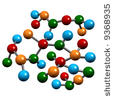In the 1960's Maureen Silson, bred Southview Pavane, who was registered as a Havana, although her coat was far paler than any other Havana, Maureen had bred. Pavane's coat colour was the lovely light, rich colour, that is now known as Cinnamon (1971).
Pavane as so far as it is known, was the first cat in the UK, to be bred in this new colour. Because Pavane was the 'first' early Cinnamons were called, by their breeders "Pavanes".
Cinnamon Gene - USA article by Jan Beardsley, NH USA
Southview Pheromone was imported into the United States in the mid to
late 70's - he was bred to several USA Oriental Shorthair, cinnamons were produced.
There were a few interested catteries, but the diehards were 3 of us -
Tokira, (Carol Furnee then of NH USA), Ellian (Linda Kochis,
Maryland USA) and Tlu (Jan Beardsley, NH USA. Of the 3 of us, I am
the only one STILL fixated on this gene!!
These original cinnamons, while not terribly typey, lived long and
healthy lives, the oldest of which that I recall was a retired girl I
placed with a friend, said kitty almost reaching her 20th birthday.
It's been as hard a go here, as it has been in the UK - we currently
have some southern bred cinnamons that are regional winners and grand
champions, but one still hears the same old song "nice ....... for a
cinnamon"
The USA has produced a somewhat small but diversified collection of
cinnamon and fawn in just about every pattern.
The USA history, would be incomplete without mentioning Debbie Borner
and her contributions. First Spotted Tabby Grand I believe in the
color - AND her lovely bi-colors .......
Our history ALSO includes the Dutch duplicate original Aby/Siamese
cross - same pedigree, different cats.
It's NOT an easy color to work with adding problems to the pie, add in Md cats, and it gets REAALLY difficult to determine color.
THE CINNAMON GENE - how it works
Pigmentation
The colours in the hair, skin and eyes, are caused by the presence of melanin. Melanin is deposited in hair shafts, in the form of microscopic granules which can vary in shape, size and arrangement, which gives a variety of colours.
There are two chemically different kinds of melanin: eumelanin and phaeomelanin. Eumelanin granules are thought to be spherical in shape, and absorb almost all light, giving black pigmentation. Phaeomelanin granules, are thought to be elongated in shape, and reflect light, in the red/orange/yellow range.
Several genes, can cause variation in the density of the the melanin granules, so other colours can be produced. The most variation is found in the black-based (eumelanistic) colours.
The following table lists the commonly accepted names for the basic colours, by genotype:
Mutations of the gene for Black give rise to Chocolate and Cinnamon. These colours are thought to be due to a smaller number of eumelanin granules in the hair shaft. These are alleles at the (B) locus; Chocolate is recessive to Black, and Cinnamon is recessive to Chocolate.
A mutation of the gene for Dense colouration produces Blue, Lilac, and Fawn. These colours are due to clustering of the particles of pigment in the hair shaft. This is called dilution. Blue is the dilute form of Black, Lilac is the dilute form of Chocolate, Fawn is the dilute form of Cinnamon.
Dilution is a mutation at the (D) locus - dilution is recessive to dense colouration.
This year (2004) - the cinnamon allele has been found, and sequenced. It is allelic with
chocolate and is definitely a discrete mutation of TRP-1 (tyrosinase
related protein-1) locus (B/b/bl).
Carole Gwyther
Cinnamon Fawn Group
Colour Table for Cinnamon and Fawn







A list of Cinnamon and Fawn Breeders, who are interested in Importing and Exporting Cats

 Cinnamon gene, History in Oriental and Siamese cats
Cinnamon gene, History in Oriental and Siamese cats






